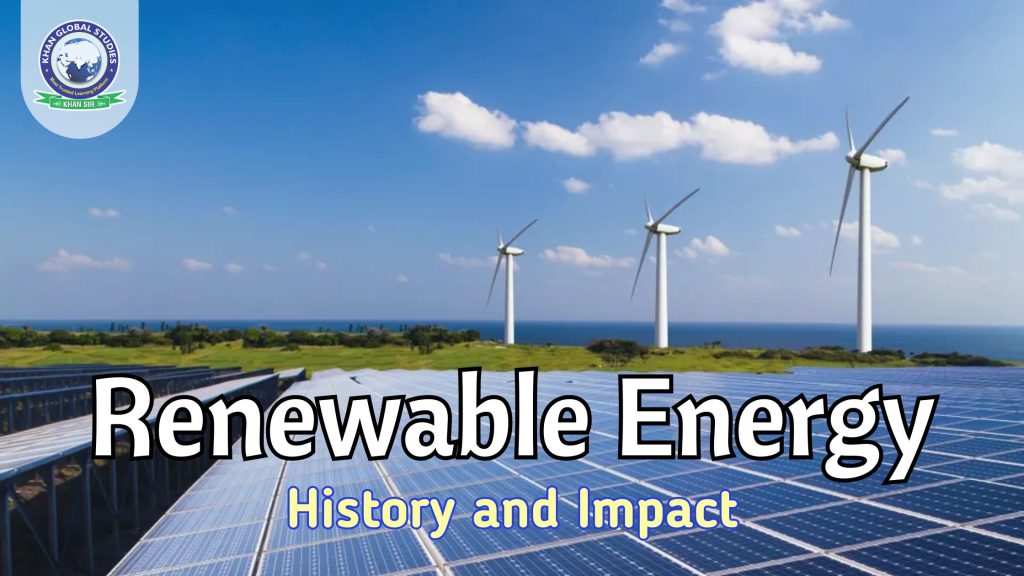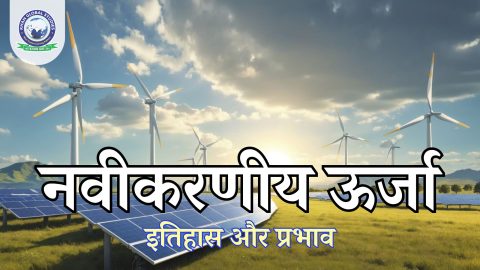Driven by the urgent need to curb climate change, reduce dependence on fossil fuels and ensure sustainable progress, renewable energy has assumed a central role in contemporary energy strategy. As the global thirst for energy continues to grow, a shift towards renewable sources has become necessary to achieve both environmental protection and economic viability.
This article attempts to examine the rise and impact of renewable energy with a special lens on the Indian landscape. We will discuss the historical evolution, different types of renewable energy sources, economic and ecological implications, policy frameworks, technological advancements, case studies, societal impacts and emerging trends.
Historical Context and Evolution
Renewable energy has a history dating back thousands of years, stretching back over 4000 years. Many civilizations have harnessed the powers of the sun, wind and water for a variety of purposes. The water wheel, a primitive invention, was in use in both China and Europe as early as the 2nd century AD, used to power mills, pumps, forge bellows and irrigation systems.
Windmills, another marvel of ancient ingenuity, used wind power for mechanical work. The Netherlands brought them to prominence in the 1590s. As for solar power, the first solar collectors were built in 1767, a watershed moment in the use of sunlight as an energy source.
Diversified Renewable Energy Sources
Solar Energy: Innovation and Applications
By 2023, India has emerged as the third-largest producer of solar power. The country’s solar generation has grown by 18 terawatt-hours (TWh). Innovations such as floating solar panels and bifacial solar modules are pushing the boundaries of efficiency and application.
Wind Energy: Technological Advancements and Efficiency
India ranks fourth globally in wind power capacity, with over 38 gigawatts of installed power. Technological advancements in turbine design and offshore wind ventures are fueling further expansion.
Hydropower: Current Trends and Environmental Considerations
Hydropower contributes about 12% of India’s total renewable energy capacity. Small-scale hydropower projects are gaining momentum, as they have comparatively less environmental impact than large dams.
Biomass Energy: Uses and Challenges
In rural India, biomass energy derived from organic matter is an important energy source. However, challenges remain in balancing the use of biomass for energy with agricultural and environmental sustainability.
Geothermal Energy: Exploration and Utilization Techniques
Geothermal energy in India is still in its infancy, with potential sites having been identified in the Himalayan region. Pilot projects are exploring its feasibility for wider application.
Economic Impacts of Renewable Energy
- Job Creation and Industry Expansion: The renewable energy sector has become a major driver of employment. In 2022, the sector in India is expected to see an eightfold growth compared to 2020-21, with around 53,000 workers employed in project development roles during 2021-22.
- Cost Competitiveness and Market Dynamics: The cost of renewable energy has declined significantly, with solar PV module prices falling by 85% over the past decade.
- Investment Opportunities and Financial Incentives: India’s renewable energy sector has attracted substantial investment, with over $10 billion invested in 2022 alone. Government incentives, including tax benefits and subsidies, continue to support this growth trajectory.
Environmental Benefits and Challenges
- Reduction in Greenhouse Gas Emissions: Renewable energy plays a vital role in reducing greenhouse gas emissions. India’s renewable energy initiatives have prevented millions of tons of CO2 emissions annually, contributing significantly to global climate goals.
- Conserving Natural Resources: Renewable energy helps preserve natural resources by reducing the need for coal, oil, and gas. This conservation is important to maintain ecological balance and prevent the depletion of essential resources.
- Addressing Gaps and Energy Storage Solutions: Gaps remain a barrier to renewables such as solar and wind. Advances in energy storage solutions, such as lithium-ion batteries and pumped hydro storage, are critical to ensure a stable energy supply.
Government Initiatives and Subsidies
- National Action Plan on Climate Change (NAPCC): The Government of India has taken several initiatives to promote renewable energy, with the NAPCC being a cornerstone policy. Launched in 2008, the NAPCC consists of eight national missions, two of which focus directly on renewable energy: the National Solar Mission and the National Mission for Enhanced Energy Efficiency.
- State-specific solar policies: Several Indian states have implemented their own solar policies to complement national efforts. States such as Gujarat, Rajasthan and Tamil Nadu have been pioneers, offering incentives such as tax exemptions, subsidies and streamlined land acquisition processes to attract investments in solar power.
- Subsidies for solar rooftops and wind power projects: The government provides capital subsidies for setting up solar rooftops, making them more affordable for residential, commercial and industrial users. The Ministry of New and Renewable Energy (MNRE) offers a subsidy of up to 40% for residential solar rooftops. Additionally, wind power projects get accelerated depreciation benefits, allowing project developers to deduct a significant portion of the project cost from their taxable income.
- Green Energy Corridor: The Green Energy Corridor project aims to facilitate the integration of renewable energy into the national grid. This includes strengthening the transmission network and ensuring grid stability. The project has received funding from the Government of India and international agencies such as the World Bank and the Asian Development Bank.
International Agreements and Collaborations
International Solar Alliance (ISA)
India co-founded the International Solar Alliance in 2015 along with France to advocate for solar energy globally. The ISA seeks to promote collaboration among member countries to increase solar energy deployment, reduce the cost of solar energy, and develop innovative financing mechanisms. By 2024, the ISA includes 119 signatory countries.
Collaborations with other countries
India has entered into several bilateral agreements to advance renewable energy. For instance, India and Germany have collaborated on various projects to enhance energy efficiency and renewable energy adoption. Similarly, India and the US have launched the US-India Clean Energy Finance Task Force to facilitate investments in clean energy projects.
Indian Context of Renewable Energy
By 2024, India will have a combined installed renewable energy capacity of 195.01 GW. The distribution is as follows:
- Wind power: 46.65 GW
- Solar power: 85.47 GW
- Biomass/cogeneration: 10.35 GW
- Small hydro: 5 GW
- Energy from waste: 0.59 GW
- Large hydro: 46.92 GW
Among the states, Rajasthan has the highest estimated renewable energy potential at 20.3%. Maharashtra and Gujarat are second with 11.79% and 10.45%, respectively.
Policy Challenges
- Grid integration: Incorporating a high share of renewable energy into the grid presents technical challenges, such as maintaining grid stability and managing interruptions. The government is working on advanced grid management techniques, including the deployment of smart grids and energy storage solutions.
- Land acquisition: Securing land for large-scale renewable energy projects, especially solar farms and wind parks, remains a significant challenge. The government is exploring ways to streamline land acquisition processes and promote the use of wastelands and wastelands for renewable energy projects.
- Financing: Despite substantial investments, financing remains a challenge, especially for smaller developers. The government is working to increase access to low-cost financing through measures such as green bonds and credit guarantee schemes. In 2022, India’s green bond issuance reached $8 billion, reflecting growing investor interest in sustainable projects.
Future Directions
- Enhanced policy frameworks: Future policy directions include strengthening frameworks to support emerging technologies such as offshore wind and advanced biofuels.
- Innovation and research: Increased funding for research and development in renewable technologies is critical. The government is encouraging public-private partnerships to foster innovation.
- Decentralised renewable energy: Promote decentralised renewable energy solutions such as solar rooftops and mini-grids to ensure energy access in remote and rural areas.
- Energy storage solutions: Develop and implement large-scale energy storage solutions to address disruptions to renewable energy sources. This includes projects such as the proposed 1 GW grid-connected battery storage system in Ladakh.
Social and Community Impact
Energy access in developing regions
Renewable energy projects are essential to provide energy access in remote and rural areas. In India, solar microgrids and biogas plants have revolutionised energy availability in underprivileged communities. For example, the quality of life in Darbari village in Uttar Pradesh improved significantly after the implementation of a solar microgrid that provided reliable electricity for the first time. This also enabled local businesses to operate more efficiently and children to study after dark, improving educational outcomes.
Community-driven renewable projects
Community participation in renewable projects enhances sustainability and local engagement. Examples include cooperative wind farms and community solar initiatives in India. A notable example is the Dharnai Solar Initiative in Bihar, led by Greenpeace India, where a 100 kW solar microgrid powered an entire village. The project provided continuous energy and fostered a sense of ownership among the villagers, leading to better maintenance and sustainability of the system.
Public perception and awareness campaigns
Public awareness campaigns, such as India’s ‘Green Energy Corridor’ initiative, play a key role in promoting the benefits of renewable energy and encouraging adoption. The Green Energy Corridor Project, launched by the Government of India, aims to integrate renewable energy into the national grid efficiently. Extensive awareness campaigns and community engagement programs under this initiative have educated the public about the importance of renewable energy, leading to increased support and faster implementation of green projects across the country.
Conclusion
This article has traced the rise and impact of renewable energy, outlining its historical evolution, economic and environmental benefits, policy landscape, technological innovations, successful case studies and societal impacts.
The need for continued innovation and investment in renewable energy cannot be underestimated. As India and the world move towards a more sustainable future, renewable energy will be instrumental in ensuring a cleaner, greener and more prosperous planet for generations to come.





